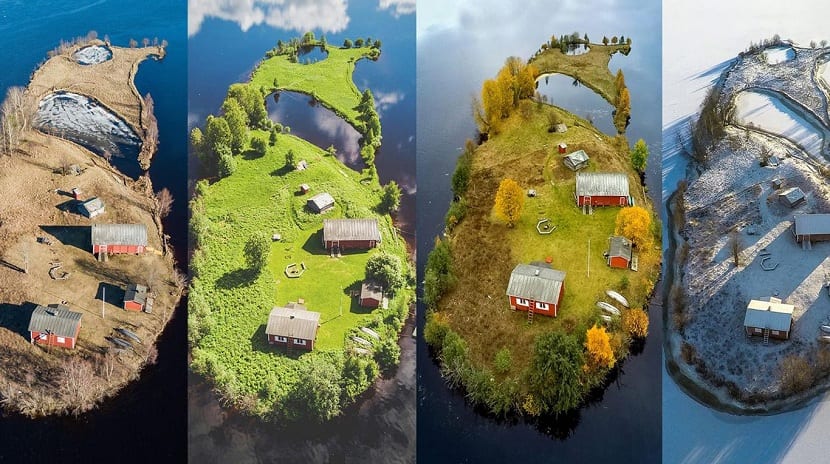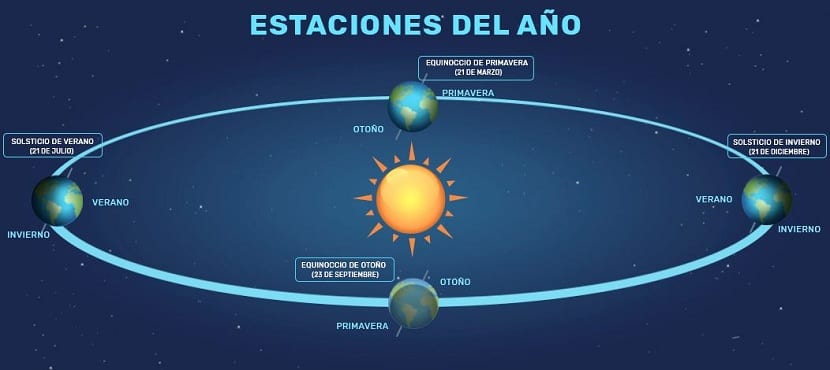
As you know, a full year on Earth has 4 seasons: fall, winter, spring and summer. The existence of the seasons is due to the movements of the earth in its orbit around the Sun. Depending on the latitude and height at which we are within the planet, the changes in meteorology and climatology can be minimum or maximum. That is, there may be seasons very significant and differential or others that are more similar.
Here we are going to explain everything you need to know about the seasons of the year in detail so that doubts are resolved.
Seasons of the year and their importance

In the mid-latitude regions of the planet, the climate changes a lot throughout the year. The climatic stations have more or less similar characteristics in all the zones of this latitude. Changes in temperatures, rainfall, winds, etc. They affect the landscape, since it is also mixed with the phenology of the living beings that inhabit them.
The landscape is also affected in urban areas since human activities also change with the seasons of the year. It is not the same to see the coastal areas in the middle of summer than in winter. Both the activities and the decoration and the presence or absence of crowds of people on the beaches modifies the landscape.
En general, We are talking about 4 seasons of the year with more or less 3 months duration. There are areas on our planet that only have two seasons a year: one wet and the other dry. This happens, for example, in monsoon areas. Monsoons are the abundant rainfall in tropical areas. They occur at a certain time of the year and cause severe flooding.
Causes and effects

We are going to know what causes the seasons of the year and what effects it produces on life on Earth. Our axis is inclined with respect to the plane of the orbit that travels around the Sun about 23 degrees. This means that some areas of the Earth receive different amounts of sunlight at different times of the year.
The variations in the climate that different parts of the planet have are more differentiated in cold and temperate zones and milder in the tropics. For example, the closer we get to the equator, the less variety there is in the climate throughout the year. This is because they almost always receive the same amount of sunlight, even though we are in different positions relative to the sun in orbit.
The seasons of the year are usually differentiated by climatic seasons. These seasons last approximately 3 months and depend on the inclination of the Earth's axis. It is possible to think that in summer it is hotter because our planet is closer to the Sun. However, this is not the case. In reverse, the distance from Earth to Sun it is greater in summer than in winter. All this we are referring to the northern hemisphere. However, as in winter there is a greater inclination of the sun's rays, the temperatures are lower.
The seasons of the year are 4: spring, summer, autumn and winter. In the first two we have the characteristics of a day longer than the night, while in the other two it is the opposite. Since the variations in climate we have mentioned are due to the inclination of the earth's axis, it does not occur in the northern hemisphere as in the south. Both hemispheres are with reversed effects. When it is summer in the northern hemisphere, in the southern hemisphere it is winter. We can also see how, when spring begins in one hemisphere, autumn begins in another.
Solstices and equinoxes

As the Earth moves with the axis of the North Pole tilted towards the Sun, the South Pole does the opposite. This means that the northern regions receive more solar radiation than those in the south.. This process is reversed and the northern hemisphere areas receive less heat as the days get shorter and the sun's rays fall steeper.
The astronomical stations are determined by the 4 main positions of the Earth's orbit around the sun. These positions called aphelion and perihelion are the ones that give rise to winter solstices y summer and vernal equinoxes and fall.
When an equinox takes place, the sun's rays are striking perpendicularly on the earth's surface, so they fall vertically at the equator. On the other hand, when the solstices take place, the opposite happens. That is, the sun's rays are hitting the earth's surface at an inclination of 23,5 degrees. This makes the Tropic of Cancer summer and the Tropic of Capricorn winter.
Not all seasons of the year last the same. This is because the orbit that the Earth travels around the Sun is not circular, but elliptical. This causes it to cause eccentricity. The Earth travels faster when it is closer to the Sun and slower when it is further away.
Relationship of the Earth's orbit with the stations

Each season of the year is not the same for each hemisphere. Earth is closest to the sun in early January, yet in the northern hemisphere we are in winter. However, in early July we are farther from the sun, but in the northern hemisphere it is summer. The boreal summer is less hot than the southern one and the winters are milder.
The seasons of the year do not always begin on the same day and at the same time due to a series of disturbances that the Earth experiences as it revolves around the Sun. If you want to know exactly when each season begins, we have to inform ourselves of television or astronomical calendars .
I hope that with this information you can learn more about the seasons of the year, why they are formed and what their characteristics are.